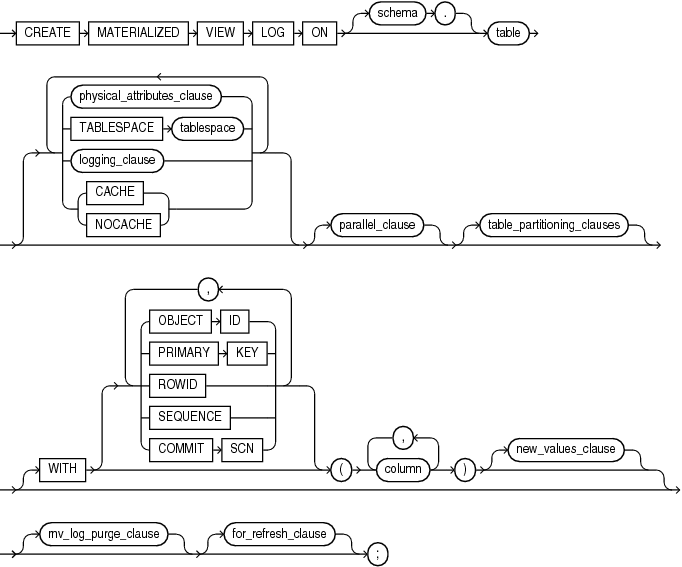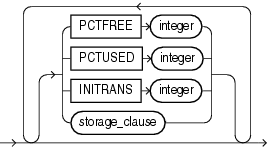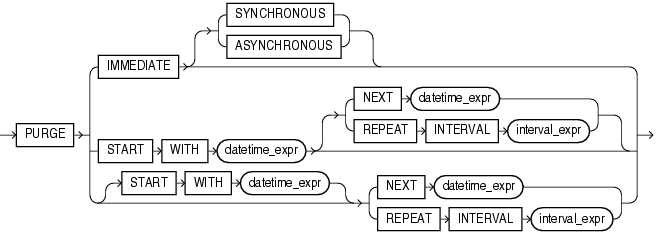CREATE MATERIALIZED VIEW LOG
Use the CREATE MATERIALIZED VIEW LOG statement to create a materialized view log, which is a table associated with the master table of a materialized view.
Note:
The keywordSNAPSHOT is supported in place of MATERIALIZED VIEW for backward compatibility.Materialized view logs are used for two types of materialized view refreshes: fast refresh and synchronous refresh.
Fast refresh uses a conventional materialized view log. During a fast refresh (also called an incremental refresh), when DML changes are made to master table data, Oracle Database stores rows describing those changes in the materialized view log and then uses the materialized view log to refresh materialized views based on the master table.
Synchronous refresh uses a special type of materialized view log called a staging log. During a synchronous refresh, DML changes are first described in the staging log and then applied to the master tables and the materialized views simultaneously. This guarantees that the master table data and materialized view data are in sync throughout the refresh process. This refresh method is useful in data warehousing environments.
Without a materialized view log, Oracle Database must reexecute the materialized view query to refresh the materialized view. This process is called a complete refresh. Usually, a complete refresh takes more time to complete than a fast refresh or a synchronous refresh.
A materialized view log is located in the master database in the same schema as the master table. A master table can have only one materialized view log defined on it.
To fast refresh or synchronous refresh a materialized join view, you must create a materialized view log for each of the tables referenced by the materialized view.
Fast refresh supports two types of materialized view logs: timestamp-based materialized view logs and commit SCN-based materialized view logs. Timestamp-based materialized view logs use timestamps and require some setup operations when preparing to refresh the materialized view. Commit SCN-based materialized view logs use commit SCN data rather than timestamps, which removes the need for the setup operations and thus can improve the speed of the materialized view refresh. If you specify the COMMIT SCN clause, then a commit SCN-based materialized view log is created. Otherwise, a time-stamp based materialized view log is created. Note that only new materialized view logs can take advantage of COMMIT SCN. Existing materialized view logs cannot be altered to add COMMIT SCN unless they are dropped and recreated. Refer to Oracle Database Data Warehousing Guide for more information.
Synchronous refresh supports only timestamp-based staging logs.
See Also:
-
CREATE MATERIALIZED VIEW, ALTER MATERIALIZED VIEW, Oracle Database Concepts, Oracle Database Data Warehousing Guide, and Oracle Database Advanced Replication for information on materialized views in general
-
ALTER MATERIALIZED VIEW LOG for information on modifying a materialized view log
-
DROP MATERIALIZED VIEW LOG for information on dropping a materialized view log
-
Oracle Database Utilities for information on using direct loader logs
The privileges required to create a materialized view log directly relate to the privileges necessary to create the underlying objects associated with a materialized view log.
-
If you own the master table, then you can create an associated materialized view log if you have the
CREATETABLEprivilege. -
If you are creating a materialized view log for a table in another user's schema, then you must have the
CREATEANYTABLEandCOMMENTANYTABLEsystem privileges, as well as either theREADorSELECTobject privilege on the master table or theREADANYTABLEorSELECTANYTABLEsystem privilege.
In either case, the owner of the materialized view log must have sufficient quota in the tablespace intended to hold the materialized view log or must have the UNLIMITED TABLESPACE system privilege.
See Also:
Oracle Database Data Warehousing Guide for more information about the prerequisites for creating a materialized view log
Description of the illustration create_materialized_vw_log.gif
(physical_attributes_clause::=, logging_clause::=, parallel_clause::=, table_partitioning_clauses ::= (in CREATE TABLE), new_values_clause::=, mv_log_purge_clause::=, for_refresh_clause::=.)

Description of the illustration physical_attributes_clause.gif

Description of the illustration logging_clause.gif

Description of the illustration parallel_clause.gif

Description of the illustration new_values_clause.gif

Description of the illustration mv_log_purge_clause.gif

Description of the illustration for_refresh_clause.gif
Specify the schema containing the materialized view log master table. If you omit schema, then Oracle Database assumes the master table is contained in your own schema. Oracle Database creates the materialized view log in the schema of its master table. You cannot create a materialized view log for a table in the schema of the user SYS.
Specify the name of the master table for which the materialized view log is to be created. Oracle Database encrypts any columns in the materialized view log that are encrypted in the master table, using the same encryption algorithm.
Restrictions on Master Tables of Materialized View Logs The following restrictions apply to master tables of materialized view logs:
-
You cannot create a materialized view log for a temporary table or for a view.
-
You cannot create a materialized view log for a master table with a virtual column.
Use the physical_attributes_clause to define physical and storage characteristics for the materialized view log.
See Also:
physical_attributes_clause and storage_clause for a complete description these clauses, including default valuesSpecify the tablespace in which the materialized view log is to be created. If you omit this clause, then the database creates the materialized view log in the default tablespace of the schema of the materialized view log.
Specify either LOGGING or NOLOGGING to establish the logging characteristics for the materialized view log. The default is the logging characteristic of the tablespace in which the materialized view log resides.
See Also:
logging_clause for a full description of this clauseFor data that will be accessed frequently, CACHE specifies that the blocks retrieved for this log are placed at the most recently used end of the least recently used (LRU) list in the buffer cache when a full table scan is performed. This attribute is useful for small lookup tables.
NOCACHE specifies that the blocks are placed at the least recently used end of the LRU list. The default is NOCACHE.
Note:
NOCACHE has no effect on materialized view logs for which you specify KEEP in the storage_clause.The parallel_clause lets you indicate whether parallel operations will be supported for the materialized view log.
For complete information on this clause, refer to parallel_clause in the documentation on CREATE TABLE.
Use the table_partitioning_clauses to indicate that the materialized view log is partitioned on specified ranges of values or on a hash function. Partitioning of materialized view logs is the same as partitioning of tables.
Use the WITH clause to indicate whether the materialized view log should record the primary key, rowid, object ID, or a combination of these row identifiers when rows in the master are changed. You can also use this clause to add a sequence to the materialized view log to provide additional ordering information for its records.
This clause also specifies whether the materialized view log records additional columns that might be referenced as filter columns, which are non-primary-key columns referenced by subquery materialized views, or join columns, which are non-primary-key columns that define a join in the subquery WHERE clause.
If you omit this clause, or if you specify the clause without PRIMARY KEY, ROWID, or OBJECT ID, then the database stores primary key values by default. However, the database does not store primary key values implicitly if you specify only OBJECT ID or ROWID at create time. A primary key log, created either explicitly or by default, performs additional checking on the primary key constraint.
OBJECT ID Specify OBJECT ID to indicate that the system-generated or user-defined object identifier of every modified row should be recorded in the materialized view log.
Restriction on OBJECT ID You can specify OBJECT ID only when creating a log on an object table, and you cannot specify it for storage tables.
PRIMARY KEY Specify PRIMARY KEY to indicate that the primary key of all rows changed should be recorded in the materialized view log.
ROWID Specify ROWID to indicate that the rowid of all rows changed should be recorded in the materialized view log.
SEQUENCE Specify SEQUENCE to indicate that a sequence value providing additional ordering information should be recorded in the materialized view log. Sequence numbers are necessary to support fast refresh after some update scenarios.
See Also:
Oracle Database Data Warehousing Guide for more information on the use of sequence numbers in materialized view logs and for examples that use this clauseCOMMIT SCN Without the COMMIT SCN clause, the materialized view log is based on timestamps and requires some setup operations when preparing to refresh the materialized view. Specify COMMIT SCN to instruct the database to use commit SCN data rather than timestamps. This setting removes the need for the setup operations and thus can improve the speed of the materialized view refresh.
You can create the following types of local materialized views (including both ON COMMIT and ON DEMAND) on master tables with commit SCN-based materialized view logs:
-
Materialized aggregate views, including materialized aggregate views on a single table
-
Materialized join views
-
Primary-key-based and rowid-based single table materialized views
-
UNIONALLmaterialized views, where eachUNIONALLbranch is one of the above materialized view types
You cannot create remote materialized views on master tables with commit SCN-based materialized view logs.
Restrictions on COMMIT SCN The following restrictions apply to COMMIT SCN:
-
Use of
COMMITSCNon a table with one or more LOB columns is not supported and causesORA-32421. -
Creating a materialized view on master tables with different types of materialized view logs (that is, a master table with timestamp-based materialized view logs and a master table with commit SCN-based materialized view logs) is not supported and causes
ORA-32414. -
If you specify
COMMITSCN, then you cannot specifyFORSYNCHRONOUSREFRESH.
column Specify the columns whose values you want to be recorded in the materialized view log for all rows that are changed. Typically these columns are filter columns and join columns.
Restrictions on the WITH Clause This clause is subject to the following restrictions:
-
You can specify only one
PRIMARYKEY, oneROWID, oneOBJECTID, oneSEQUENCE, and one column list for each materialized view log. -
Primary key columns are implicitly recorded in the materialized view log. Therefore, you cannot specify any of the following combinations if
columncontains one of the primary key columns:WITH ... PRIMARY KEY ... (column) WITH ... (column) ... PRIMARY KEY WITH (column)
See Also:
-
CREATE MATERIALIZED VIEW for information on explicit and implicit inclusion of materialized view log values
-
Oracle Database Advanced Replication for more information about filter columns and join columns
-
"Specifying Filter Columns for Materialized View Logs: Example" and "Specifying Join Columns for Materialized View Logs: Example"
The NEW VALUES clause lets you determine whether Oracle Database saves both old and new values for update DML operations in the materialized view log.
INCLUDING Specify INCLUDING to save both new and old values in the log. If this log is for a table on which you have a single-table materialized aggregate view, and if you want the materialized view to be eligible for fast refresh, then you must specify INCLUDING.
EXCLUDING Specify EXCLUDING to disable the recording of new values in the log. This is the default. You can use this clause to avoid the overhead of recording new values. Do not use this clause if you have a fast-refreshable single-table materialized aggregate view defined on the master table.
Use this clause to specify the purge time for the materialized view log.
-
IMMEDIATESYNCHRONOUS: the materialized view log is purged immediately after refresh. This is the default. -
IMMEDIATEASYNCHRONOUS: the materialized view log is purged in a separate Oracle Scheduler job after the refresh operation. -
STARTWITH,NEXT, andREPEATINTERVALset up a scheduled purge that is independent of the materialized view refresh and is initiated duringCREATEorALTERMATERIALIZEDVIEWLOGstatement. This is very similar to scheduled refresh syntax in aCREATEorALTERMATERIALIZEDVIEWstatement:-
The
STARTWITHdatetime expression specifies when the purge starts. -
The
NEXTdatetime expression computes the next run time for the purge.
If you specify
REPEATINTERVAL, then the next run time will be:SYSDATE +interval_expr.A
CREATEMATERIALIZEDVIEWLOGstatement with a scheduled purge creates an Oracle Scheduler job to perform log purge. The job calls theDBMS_SNAPSHOT.PURGE_LOGprocedure to purge the materialized view logs. This process allows you to amortize the purging costs over several materialized view refreshes. -
Restriction on mv_log_purge_clause This clause is not valid for materialized view logs on temporary tables.
See Also:
Oracle Database Data Warehousing Guide for more information on purging materialized view logsUse this clause to specify the refresh method for which the materialized view log will be used. You can specify only one refresh method for any given master table.
FOR SYNCHRONOUS REFRESH Specify this clause to create a staging log that can be used for synchronous refresh. Use staging_log_name to specify the name of the staging log to be created. The staging log will be created in the schema in which the master table resides.
After you create the staging log, you cannot perform DML operations directly on the master table. You must use the procedures in the DBMS_SYNC_REFRESH package to prepare and execute change data operations.
Restrictions on Synchronous Refresh The following restrictions apply to synchronous refresh:
-
If you specify
FORSYNCHRONOUSREFRESH, then you cannot specifyCOMMITSCN. -
To be eligible for synchronous refresh, the master table must satisfy the following criteria:
-
If the master table is a fact table, then it must be partitioned.
-
The master table must have a key. If the master table is a dimension table, then it must have a primary key defined on it. If the master table is a fact table, then the set of columns that are the foreign keys of the dimension tables joined to the fact table are deemed to be the key.
-
The master table cannot have a non-NULL Virtual Private Database (VPD) policy or a trigger defined on it.
Oracle Database may allow you to create a staging log on a master table even if all of the preceding criteria are not met. However, the master table will not be eligible for synchronous refresh.
-
-
Any existing materialized views on the master table must be refresh-on-demand materialized views. If an existing materialized view is a refresh-on-commit materialized view, then you must change it to a refresh-on-demand materialized view with the alter_mv_refresh clause of
ALTERMATERIALIZEDVIEWbefore you create the staging log.
See Also:
-
Oracle Database Data Warehousing Guide for the complete steps for using synchronous refresh
-
Oracle Database PL/SQL Packages and Types Reference for information on the
DBMS_SYNC_REFRESHpackage
FOR FAST REFRESH Specify this clause to create a materialized view log that can be used for fast refresh. The materialized view log will be created in the same schema in which the master table resides. This is the default.
Creating a Materialized View Log for Fast Refresh: Examples The following statement creates a materialized view log on the oe.customers table that specifies physical and storage characteristics:
CREATE MATERIALIZED VIEW LOG ON customers PCTFREE 5 TABLESPACE example STORAGE (INITIAL 10K);
The materialized view log on customers supports fast refresh for primary key materialized views only.
The following statement creates another version of the materialized view log with the ROWID clause, which enables fast refresh for more types of materialized views:
CREATE MATERIALIZED VIEW LOG ON customers WITH PRIMARY KEY, ROWID;
This materialized view log on customers makes fast refresh possible for rowid materialized views and for materialized join views. To provide for fast refresh of materialized aggregate views, you must also specify the SEQUENCE and INCLUDING NEW VALUES clauses, as shown in the example that follows.
Specify a Purge Repeat Interval for a Materialized View Log: Example The following statement creates a materialized view log on the oe.orders table. The contents of the log will be purged once every five days, beginning five days after the creation date of the materialized view log:
CREATE MATERIALIZED VIEW LOG ON orders PCTFREE 5 TABLESPACE example STORAGE (INITIAL 10K) PURGE REPEAT INTERVAL '5' DAY;
Specifying Filter Columns for Materialized View Logs: Example The following statement creates a materialized view log on the sh.sales table and is used in "Creating Materialized Aggregate Views: Example". It specifies as filter columns all of the columns of the table referenced in that materialized view.
CREATE MATERIALIZED VIEW LOG ON sales WITH ROWID, SEQUENCE(amount_sold, time_id, prod_id) INCLUDING NEW VALUES;
Specifying Join Columns for Materialized View Logs: Example The following statement creates a materialized view log on the order_items table of the sample oe schema. The log records primary keys and product_id, which is used as a join column in "Creating a Fast Refreshable Materialized View: Example".
CREATE MATERIALIZED VIEW LOG ON order_items WITH (product_id);
Including New Values in Materialized View Logs: Example The following example creates a materialized view log on the oe.product_information table that specifies INCLUDING NEW VALUES:
CREATE MATERIALIZED VIEW LOG ON product_information WITH ROWID, SEQUENCE (list_price, min_price, category_id), PRIMARY KEY INCLUDING NEW VALUES;
You could create the following materialized aggregate view to use the product_information log:
CREATE MATERIALIZED VIEW products_mv
REFRESH FAST ON COMMIT
AS SELECT SUM(list_price - min_price), category_id
FROM product_information
GROUP BY category_id;
This materialized view is eligible for fast refresh because the log defined on its master table includes both old and new values.
Creating a Staging Log for Synchronous Refresh: Example The following statement creates a staging log on the sh.sales fact table. The staging log is named mystage_log and is stored in the sh schema. It can be used for synchronous refresh.
CREATE MATERIALIZED VIEW LOG ON sales PCTFREE 5 TABLESPACE example STORAGE (INITIAL 10K) FOR SYNCHRONOUS REFRESH USING mystage_log;